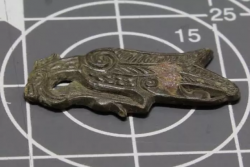INSTITUT SUPERIEUR D'ANTHROPOLOGIE
INSTITUTE OF ANTHROPOLOGY
ONLINE COURSES / COURS A DISTANCE
SUMMER TERM : JULY 2017
REGISTER NOW
ISRAEL –  Ramat Beit Shemesh - An Ottoman-era water well and sophisticated storage system were recently unearthed by archeologists conducting an excavation near Ramat Beit Shemesh, outside of Jerusalem. The well is 3.5 meters deep, and is connected to a reservoir of ground water featuring a vaulted ceiling.
Ramat Beit Shemesh - An Ottoman-era water well and sophisticated storage system were recently unearthed by archeologists conducting an excavation near Ramat Beit Shemesh, outside of Jerusalem. The well is 3.5 meters deep, and is connected to a reservoir of ground water featuring a vaulted ceiling.
http://www.jpost.com/Israel-News/Sophisticated-Ottoman-era-water-well-and-reservoir-unearthed-near-Beit-Shemesh-494210
INDE –  Keezhadi -The third phase of excavation work started at Keezhadi archaeological site in Sivaganga district. Sriraman said the third phase of excavation is carried out adjacent to excavation works of Phase 2. "It will help us to study the continuation of the brick structures found in previous excavation phase. Based on findings in the first two or three trenches we will decide the expansion of trenches," he said.
Keezhadi -The third phase of excavation work started at Keezhadi archaeological site in Sivaganga district. Sriraman said the third phase of excavation is carried out adjacent to excavation works of Phase 2. "It will help us to study the continuation of the brick structures found in previous excavation phase. Based on findings in the first two or three trenches we will decide the expansion of trenches," he said.
http://timesofindia.indiatimes.com/city/madurai/3rd-phase-of-excavation-begins-at-keezhadi/articleshow/58878592.cms
ROYAUME UNI –  Bamburgh - The continued archaeological investigation of Bamburgh Castle, once the palace site of the early medieval kings of Northumbria, has revealed a marvellous new find of national significance. The copper alloy fragment is small, 23mm by 12mm, but beautifully decorated with an intricate zoomorphic representation of a bird, characteristic of early medieval north European art. It is fascinating that the new image appears to hark back in time to the bird of prey motifs of the 6th and 7th centuries AD and could represent a descendant of these earlier styles just as the later 8th century York helmet, is an update of the form known from the earlier Sutton Hoo, Staffordshire and Wollaston helmets.
Bamburgh - The continued archaeological investigation of Bamburgh Castle, once the palace site of the early medieval kings of Northumbria, has revealed a marvellous new find of national significance. The copper alloy fragment is small, 23mm by 12mm, but beautifully decorated with an intricate zoomorphic representation of a bird, characteristic of early medieval north European art. It is fascinating that the new image appears to hark back in time to the bird of prey motifs of the 6th and 7th centuries AD and could represent a descendant of these earlier styles just as the later 8th century York helmet, is an update of the form known from the earlier Sutton Hoo, Staffordshire and Wollaston helmets.
http://www.northumberlandgazette.co.uk/news/bamburgh-dig-uncovers-unique-find-1-8556013
FRANCE –  Val Suzon - C’est une découverte archéologique inédite qui vient d’être faite dans la forêt communale de Val-Suzon, à une dizaine de kilomètres de Dijon, en Côte-d’Or. Les archéologues ont trouvé des garennes (des constructions pour l’élevage des lapins) datant du Moyen Âge. C’est grâce à une prospection LiDAR (qui permet d'étudier la topographie du sol malgré la végétation) que le site a été repéré en 2016. Les relevés ont montré cinq mystérieux monticules rectangulaires regroupés en bordure de forêt. Un premier indice d'interprétation a été apporté par un document du XVIe siècle trouvé aux Archives départementales de Côte-d’Or. "Celui-ci relate un conflit entre les religieux de la Sainte-Chapelle de Dijon, alors seigneurs de Val-Suzon, et les habitants de la commune voisine d'Étaules. Dans ce texte, la présence de "garennes à lapins" est mentionnée à proximité du hameau de Sainte-Foy, sans que leur localisation précise ne soit pour autant donnée", explique Rémi Landois, le doctorant responsable de l’opération. Une prospection géophysique, puis un sondage archéologique ont permis de confirmer l’existence de ces garennes.
Val Suzon - C’est une découverte archéologique inédite qui vient d’être faite dans la forêt communale de Val-Suzon, à une dizaine de kilomètres de Dijon, en Côte-d’Or. Les archéologues ont trouvé des garennes (des constructions pour l’élevage des lapins) datant du Moyen Âge. C’est grâce à une prospection LiDAR (qui permet d'étudier la topographie du sol malgré la végétation) que le site a été repéré en 2016. Les relevés ont montré cinq mystérieux monticules rectangulaires regroupés en bordure de forêt. Un premier indice d'interprétation a été apporté par un document du XVIe siècle trouvé aux Archives départementales de Côte-d’Or. "Celui-ci relate un conflit entre les religieux de la Sainte-Chapelle de Dijon, alors seigneurs de Val-Suzon, et les habitants de la commune voisine d'Étaules. Dans ce texte, la présence de "garennes à lapins" est mentionnée à proximité du hameau de Sainte-Foy, sans que leur localisation précise ne soit pour autant donnée", explique Rémi Landois, le doctorant responsable de l’opération. Une prospection géophysique, puis un sondage archéologique ont permis de confirmer l’existence de ces garennes.
Il s'agit de galeries artificielles creusées par l'homme qui sont ensuite recouvertes de pierres puis de terre pour former une petite butte. Ces constructions médiévales, destinées à l'élevage de lapins en semi-liberté, sont liées à un privilège seigneurial. "Celles-ci datent au moins du XVIe siècle mais leur création est certainement plus ancienne", précisent les chercheurs. Cette découverte permet d’enrichir les recherches archéologiques et historiques actuellement en cours sur le territoire du Val Suzon. On a pu ainsi détecter dans la forêt de Val-Suzon un important parcellaire gallo-romain préservé par la végétation.
http://france3-regions.francetvinfo.fr/bourgogne-franche-comte/cote-d-or/archeologie-garennes-lapins-du-moyen-age-decouvertes-foret-val-suzon-1259793.html